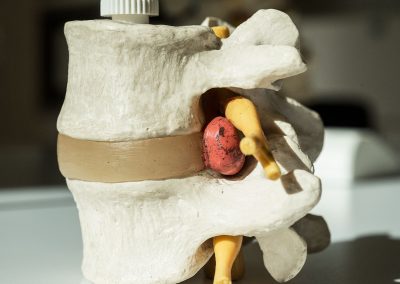What is a disc prolapse?
Definition, Common Causes, Therapy, Results
Definition of a disc prolapse?
A disc prolapse (herniated disc) is a rupture of the intervertebral disc with extrusion of disc material into the spinal canal that causes pressure upon spinal nerve roots. This causes radiating pain into the arms or legs. Tingling sensations or weakness corresponding to the pinched spinal nerves may also occur.
Common causes of a disc prolapse
The following conditions may cause a disc prolapse:
- inherited weakness of the disc tissues
- sudden rotational movements
- heavy lifting, pushing or pulling
Furthermore, a disc prolapse may be caused by no apparent reason. In this case, the cause of the disc prolapse might be a strain of an already degenerated disc.
Therapy of prolapsed disc
Rest for about two weeks and/or treating back pain with anti-inflammatory medication is often sufficient to ease the acute pain. Exercises, under professional supervision of a physical therapist, to strengthen back and abdominal muscles are highly recommended. Supplementary application of hot-packs, electrotherapy or chiropractic treatment may relieve the pain too.
In general, bending, heavy lifting and pushing should be avoided. If pain continues, or tingling or muscular weakness is apparent, surgery is necessary to avoid irreparable damages such as incontinence or paralysis.
“keyhole surgery”, safe and efficient!
Endoscopic surgery allows, in most cases, a tissue sparing approach to remove the prolapsed disc material.
Predominantly, good or outstanding results are achieved. Low back pain, especially leg pain, disappears rapidly, improving the quality of life for patients.
This film shows a systematic animation of an endoscopic disc surgery. By clicking here, you can watch a real endoscopic surgery XXX
No general anaesthetic thanks to keyhole surgery
When undergoing endoscopic surgery, local anaesthetic is sufficient – general anaesthetic is not needed. Supervision of an anaesthetist guarantees optimal pain management.
During an endoscopic surgery an endoscope, with a diameter of no more than 7 millimetres, is introduced through a small opening and led to the prolapsed disc. The prolapsed disc or extruded disc material can be removed precisely. In this way, the pinched spinal nerve roots are freed. Back and leg pain will disappear shortly thereafter.
During an endoscopic surgery an endoscope, with a diameter of no more than 7 millimetres, is introduced through a small opening and led to the prolapsed disc. The prolapsed disc or extruded disc material can be removed precisely. In this way, the pinched spinal nerve roots are freed. Back and leg pain will disappear shortly thereafter.
Nearly no pain or scars
Due to the fact that endoscopic surgery is not an open surgery, complications, pain and scars are rare. Usually, the patient can leave the hospital the day after surgery. In cases of younger patients ambulant endoscopic surgery is possible.
How soon can I work again?
Office work can be picked up after one or two weeks. Physical labour should be conducted restrictedly for six weeks. Thereafter, it can be increased slowly.
Can I do sports?
Generally, endoscopic surgery allows engaging in all sports. Swimming and biking is possible two weeks after surgery. Other sports can be carried out after a period of six weeks.
Is keyhole surgery dangerous?
Contrary to open endoscopic surgery, the difference and advantage of keyhole surgery lies in the fact that the prolapsed disc is approached from the side. Thus, chances of damaging nerves or discs are slim. Furthermore, due to the local anaesthetic, endoscopic surgery is more convenient for patients.
Results
Endoscopic surgery leads to quick relief of lower back pain. A good result is achieved in over 90% of cases, meaning that lower back pain disappears and does not return. Immediate re-integration into daily life is guaranteed. Even all sorts of physical activities can, again, be conducted. Only in 5 to 8% of surgeries might a second disc prolapse appear and new consultation will be needed.

